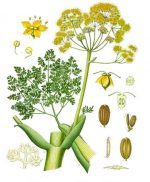 Native to the mountains of Iran and Turkmenistan, this herbaceous perennial is a member of the parsley family, Apiaceae, that also includes carrots, celery, and poison hemlock. Growing from a thick taproot, the plant is about 3′ tall and has a smooth, hollow stem. The finely divided tripinnate leaves have a stout basal sheath clasping the stem. In late spring umbels of small yellow flowers appear and produce seeds that ripen in summer. A fetid yellowish-brown gum resin called galbanum is produced by the stem of the plant and is valued for its medicinal qualities. In addition, the gum resin was used by the ancient Egyptians and Israelites as an ingredient in incense. Photo Credit Wikipedia
Native to the mountains of Iran and Turkmenistan, this herbaceous perennial is a member of the parsley family, Apiaceae, that also includes carrots, celery, and poison hemlock. Growing from a thick taproot, the plant is about 3′ tall and has a smooth, hollow stem. The finely divided tripinnate leaves have a stout basal sheath clasping the stem. In late spring umbels of small yellow flowers appear and produce seeds that ripen in summer. A fetid yellowish-brown gum resin called galbanum is produced by the stem of the plant and is valued for its medicinal qualities. In addition, the gum resin was used by the ancient Egyptians and Israelites as an ingredient in incense. Photo Credit Wikipedia
The Hebrew word chelbenah translated as galbanum proabably refers to Ferula galbaniflua although other species of Ferula have been offered as alternatives. Galbanum, the gum resin derived from the stem of Ferula plants, is obtained by making a transverse incision in a young stem a few inches above the ground. The exude is light brown, greenish yellow, or yellowish and has a strong pungent odor when burned.
Exodus 30:34 (NIV) Directions are given for making the consecrated incense, ketoret.
“Then the LORD said to Moses, “Take fragrant spices—gum resin, onycha and galbanum—and pure frankincense, all in equal amounts,”
Ecclesiasticus 24:15 (NIV) Wisdom praises herself.
“My breath was the spicy smell of cinnamon, of sweet perfume and finest myrrh, of stacte, onycha, and galbanum, the fragrant incense in the Sacred Tent.”
Plants likes full sun and fertile, medium moist to dry, well-drained soil in USDA Hardiness Zones 5-9. Propagation is by seed.
The genus name, Ferula, is the Latin word for the hollow light rod made from this plant and used for walking sticks, splints, stirring boiling liquids, and corporal punishment. The specific epithet, galbaniflua, comes the Semitic word galbana, the gum resin produced by the plant, and the Latin word fluo meaning flow suggesting the way it moves out of a wounded stem.